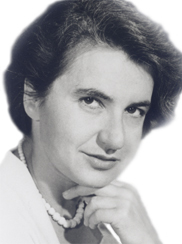« Prev Next »

Rosalind Franklin: A Crucial Contribution

A crucial contribution. Rosalind Franklin made a crucial contribution to the discovery of the double helix structure of DNA, but some would say she got a raw deal. Biographer Brenda Maddox called her the "Dark Lady of DNA," based on a once disparaging reference to Franklin by one of her coworkers. Unfortunately, this negative appellation undermined the positive impact of her discovery. Indeed, Franklin is in the shadows of science history, for while her work on DNA was crucial to the discovery of its structure, her contribution to that landmark discovery is little known.
Her education. Franklin was born on July 25, 1920, in London, to a wealthy Jewish family who valued education and public service. At age 18, she enrolled in Newnham Women's College at Cambridge University, where she studied physics and chemistry. After Cambridge she went to work for the British Coal Utilization Research Association where her work on the porosity of coal became her Ph.D. thesis, and later it would allow her to travel the world as an guest speaker.
In 1946, Franklin moved to Paris where she perfected her skills in X-ray crystallography, which would become her life's work. Although she loved the freedom and lifestyle of Paris, she returned after four years to London to accept a job at King's College.
An unhappy time. A misunderstanding resulted in immediate friction between Wilkins and Franklin, and their clashing personalities served to deepen the divide. The two were to work together on finding the structure of DNA, but their conflicts led to them working in relative isolation. While this suited Franklin, Wilkins went looking for company at "the Cavendish" laboratory in Cambridge where his friend Francis Crick was working with James Watson on building a model of the DNA molecule.
Unknown to Franklin, Watson and Crick saw some of her unpublished data, including the beautiful "photo 51," shown to Watson by Wilkins. This X-ray diffraction picture of a DNA molecule was Watson's inspiration (the pattern was clearly a helix). Using Franklin's photograph and their own data, Watson and Crick created their famous DNA model. Franklin's contribution was not acknowledged, but after her death Crick said that her contribution had been critical.
On to better things. Franklin moved to Birkbeck College where, ironically, she began working on the structure of the tobacco mosaic virus, building on research that Watson had done before his work on DNA. During the next few years she did some of the best and most important work of her life, and she traveled the world talking about coal and virus structure. However, just as her career was peaking, it was cut tragically short when she died of ovarian cancer at age 37.
Further Exploration
Key Concepts
double helix




















